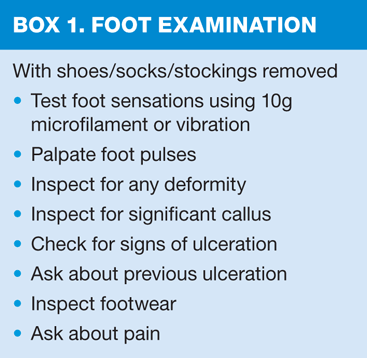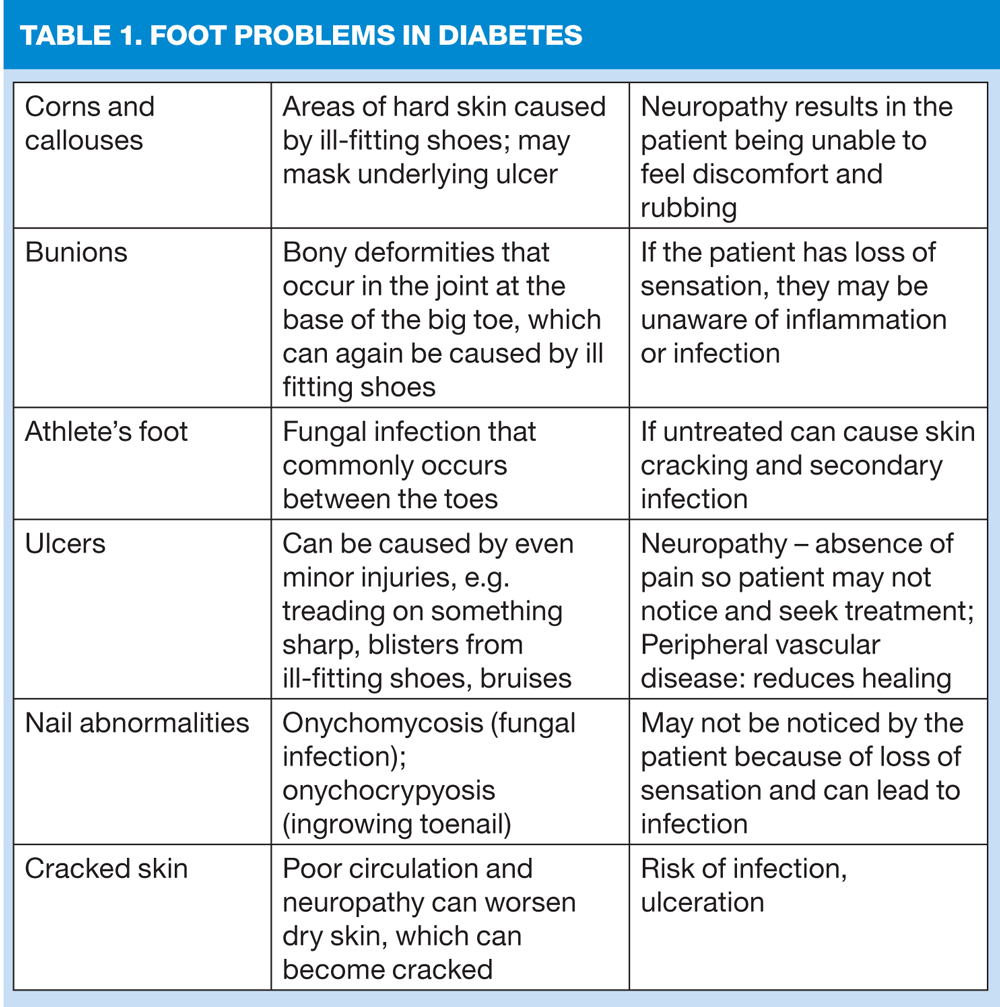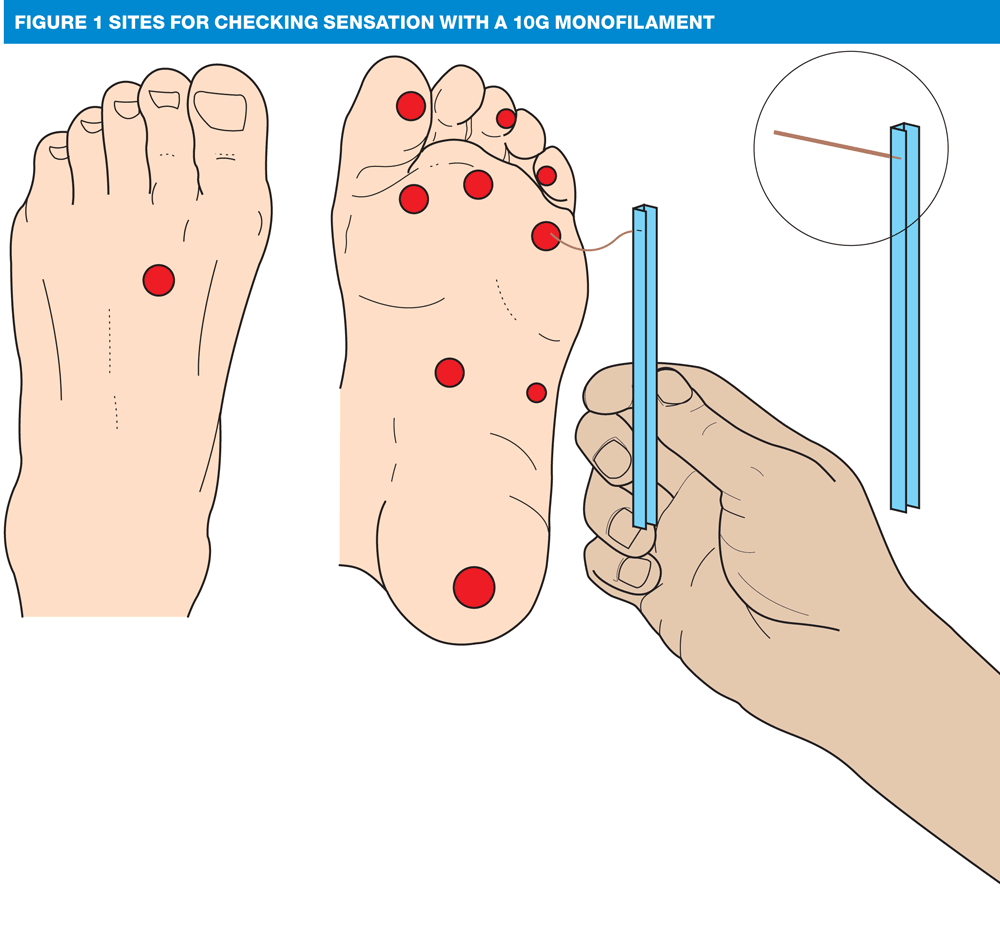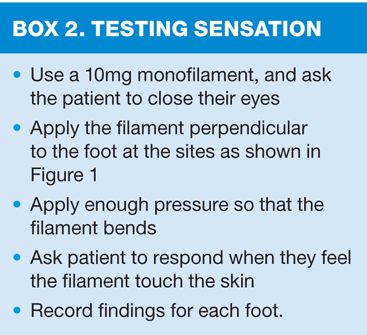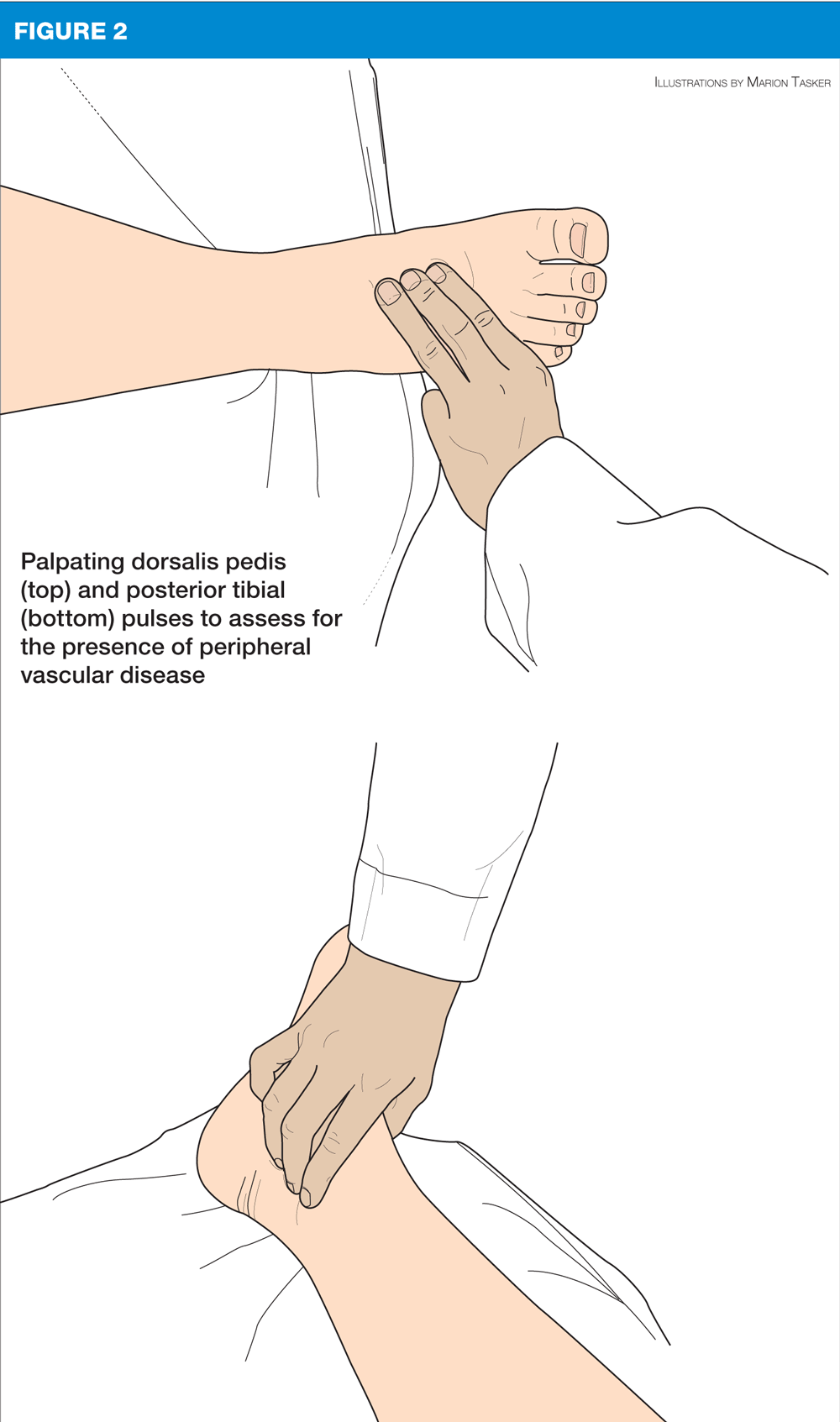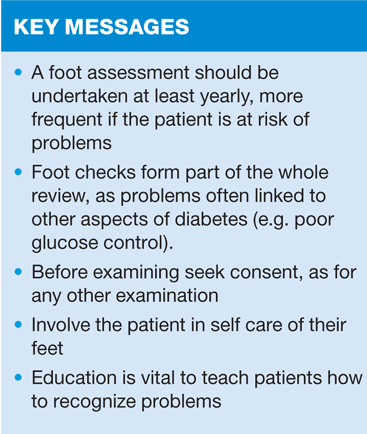Diabetic footcare Part 2: The diabetic foot review
Margaret Perry
Margaret Perry
RGN BSc(Hons) MSC
Advanced Nurse Practitioner, West Bromwich
The foot check forms an essential part of the annual review of patients with diabetes. In the second of our two-part article on diabetic footcare we look in detail at what is involved
Foot complications in diabetes are of concern because, if neglected, they can ultimately lead to amputation, of which there are approximately 120 each week in England. (Diabetic footcare, Part 1: Following the footcare pathway to avoid diabetic amputations, Clinical/Diabetes). This has a devastating effect on the affected individual and their quality of life, capacity for employment and independence, aside from the financial burden for the NHS.
Results from the National Diabetes Audit suggested that although the number of patients receiving a foot examination had improved in the 2010-2011 period, there were still 15.6% of people with diabetes who did not have an annual foot check.1 A regular foot examination is recommended at least annually and should form part of the diabetes review, however for this to be effective practice nurses need to have had appropriate training and to feel confident in performing this time consuming but important task efficiently.
POTENTIAL PROBLEMS
Diabetes can cause a number of potential foot problems some more serious than others. Approximately 20—40% of people with diabetes have neuropathy and a further 20—40% have peripheral vascular disease (PVD).2 Both of these problems occur alongside factors such as poor blood glucose control, and additional risk factors such as abnormal cholesterol levels and smoking. Where neuropathy and peripheral vascular disease exist, there is a risk of ulceration, which if left untreated, can become infected potentially leading to the need for amputation. Around 5% of people with diabetes may develop a foot ulcer in any year, and amputation rates are often around 0.5% per year.2
NICE guidance indicates that with appropriate and careful management serious complications can be delayed and in some cases prevented.2
VISUAL INSPECTION
Before examination begins patient consent is needed. Once the patient has agreed and understands what is to be done, the assessment should begin with visual inspection. Ensure good light is available for adequate inspection, and ask the patient to remove their shoes and socks so both feet can be thoroughly examined. It is also worth looking at the shoes to assess for their suitability, because inappropriate footwear and foot deformities are common contributory factors in the development of foot ulceration.3 Excessively worn shoes may indicate deformities, while shoes which are too small and tightly fitting cause rubbing, blisters or callus formation. An ischaemic foot will be cool to the touch, pale and hair growth absent. Foot problems that may be found on visual inspection are shown in table 1.
FOOT DEFORMITIES
Two common foot deformities are claw toes and hammer toes. The former has been defined as extension of the metatarsophalangeal joint, the latter as flexion in the proximal interphalangeal joint.4 These deformities increase plantar pressure and are therefore a risk factor for breakdown of skin.5 Another important, and often overlooked or misdiagnosed condition is Charcot arthropathy.6 This problem occurs in patients with neuropathy and may present as a unilateral red, hot, swollen, flat foot with visible deformity.7 Any patient suspected of having this condition should be referred immediately to a specialist for further assessment and care.
PERIPHERAL NEUROPATHY AND LOSS OF SENSATION
Peripheral neuropathy is the term used to describe damage to the peripheral nervous system and it is the most common component cause in the pathway to diabetic foot ulceration.6 There are several other types of neuropathy but peripheral neuropathy is the commonest type in diabetes,8 and is responsible for symptoms of discomfort, pain and loss of feeling in the extremities. Several methods are available to assess loss of sensation, but in primary care assessment is usually carried out using a 10g monofilament, by palpation of foot pulses and by testing vibration. NICE guidance suggests using either the monofilament or vibration (using biothesiometer or calibrated tuning fork).2
10g monofilament
Monofilament testing is commonly used worldwide for the detection of diabetic peripheral neuropathy and is considered the best choice for clinical screening for diabetic peripheral neuropathy for several reasons including its portability, ease of administration, acceptability to patients and low cost.9 Research indicates that as well as being inexpensive, the test is reliable and easy to use, and is a good clinical indicator for identifying patients who are at risk for developing foot ulcers and subsequent amputations.10 The procedure for testing is shown in box 2 and sites to check in Figure 1.
Assessment of foot pulses
Vascular examination and the assessment of peripheral artery disease (PAD) is an important part of the foot examination and includes palpation of the posterior tibial and dorsalis pedis pulses to assess for the presence or reduction of blood flow to the extremeties. The assessment of PAD is regarded as important in defining overall lower-extremity risk status.6 Sites for palpation are shown in Figure 2.
Further testing
Diabetic patients with signs or symptoms of vascular disease, (such as ulceration, claudication, Charcot foot or history of amputation) or absent pulses on examination should undergo ankle brachial pressure index (ABI) pressure testing and should be referred to the Multidisciplinary Footcare Team for further assessment. 6 The ABI test is undertaken using a Dopplar ultrasonic probe, which measures blood pressure at the ankle. The ABI is obtained by dividing the ankle systolic pressure by the higher of the two brachial systolic pressures.11 An ABI >0.9 is normal, <0.8 is associated with claudication, and <0.4 is commonly associated with ischemic rest pain and tissue necrosis.6
Vibration
Use of a tuning fork as part of the foot examination provides a useful assessment of vibratory sensation which should be tested over the tip of the great toe on each foot. An abnormal response can be defined as when the patient loses vibratory sensation, and absence of vibration sensation at the great toe is significantly associated with the risk of development of foot ulcers.12
ASSESSMENT OF FOOT RISK
Findings from the above are used to give an indication of risk of a 'foot attack'. The Diabetes UK Footcare pathway (Clinical/Diabetes) indicates that the absence of risk factors (i.e. the presence of normal sensation and palpable pulses) indicates low risk, neuropathy or absent pulses indicates moderate (increased) risk, while any patient with neuropathy or absent pulses, deformity or skin changes in a previous ulcer, or with a history of foot ulceration plus other risk factors is at high risk of foot ulceration.13
Patient education
Patients should be encouraged to self monitor their feet and report any concerns. The majority of patients can be encouraged to take care of their feet, and practice nurses have a vital role to play in ensuring patients understand how important this is in preventing future problems. NICE guidance suggests a number of self care measures, including daily washing of the feet, regular nail care and wearing comfortable well fitting shoes.2 Patients should also be discouraged from walking barefoot, and given advice on footcare while on holiday, for example, avoiding walking across hot beaches bare foot. Encouragement to seek advice in the event of any problems should be reinforced at every opportunity, as early recognition of the patient's diabetic foot problems, together with early involvement of the multidisciplinary foot care team, can help improve the prognosis for people with diabetic foot problems.14 Extra vigilance is advised for people who are older (over 70 years of age), who have had diabetes for a long time, who have poor vision, have poor footwear, who smoke, who are socially deprived or who live alone.2 Any patients who have difficulty in participating in self care measures should be seen more frequently and referred to the foot protection team if necessary.
CONCLUSION
Foot care in diabetes is an important part of the diabetic review and with continual assessment and monitoring, together with advice and education many foot problems can be avoided or detected early. Practice nurses have the opportunity to play an active part in the assessment of the diabetic foot, making sure adequate call and recall systems are in place to ensure patients are given the opportunity to attend. They are also key to the education of patients, which should be reinforced at every review, with the aim of improving not only the quality of life of patients with diabetes but also the quality of diabetic care given to patients
REFERENCES
1. Department of Health. The management of adult diabetes services in the NHS. The Stationary Office. London, 2012.
2. NICE. Type 2 diabetes: Prevention and management of foot problems. Clinical Guideline 10; NICE: London
3. Mayfield JA, Reiber GE, Sanders LJ, Janisse D, Pogach LM: Preventive foot care in people with diabetes. Diabetes Care 1998;21:2161—2177
4. Schrier JC, Verheyen CC, Louwerens JW. Definitions of hammer toe and claw toe: an evaluation of the literature J Am Podiatr Med Assoc. 2009 May-Jun;99(3):194-7.
5. Mueller MJ, Hastings MK, Commean PK, Smith KE, Pilgram TK, Robertson D, Johnson J: Forefoot structural predictors of plantar pressures during walking in people with diabetes and peripheral neuropathy. J Biomech 2003;36:1009—1017
6. Boulton AJM, Armstrong DG, and Albert SF. Comprehensive Foot Examination and Risk Assessment: A report of the Task Force of the Foot Care Interest Group of the American Diabetes Association, with endorsement by the American Association of Clinical Endocrinologists. Diabetes Care 2008;31:1679-1685.
7. Lavery LA, Peters EJ, Williams JR, Murdoch DP, Hudson A, Lavery DC: Reevaluating how we classify the diabetic foot: restructuring the diabetic foot risk classification system of the International Working Group on the Diabetic Foot. Diabetes Care 2008;31:154—156
8. National Diabetes Information Clearinghouse (NDIC). Diabetic Neuropathies: The Nerve Damage of Diabetes. 2012. http://diabetes.niddk.nih.gov/dm/pubs/neuropathies/#diagnosis
9. Mayfield JA, Sugarman JR. The use of the Semmes-Weinstein monofilament and other threshold tests for preventing foot ulceration and amputation in persons with diabetes. J Fam Pract. 2000;49(Suppl.11):S17-29.
10. Wu SC, Driver VR, Wrobel JS, Armstrong DG. Foot ulcers in the diabetic patient, prevention and treatment. Vasc Health Risk Manag 2007;3(1):65-76.
11. American Diabetes Association: Peripheral arterial disease in people with diabetes (Consensus Statement). Diabetes Care 2003;26:3333—3341
12. Boyko E, Ahroni JH, Stensel V, et al. A prospective study of risk factors for diabetic foot ulcer. The Seattle diabetic foot study. Diabetes Care. 1999;22(7):1036-1042.
13. Diabetes UK. Fast Track For A Foot Attack: Reducing Amputations. Available at www.diabetes.org.uk
14. NICE. Costing statement: Inpatient management of diabetic foot problems. (2011) http://www.nice.org.uk/nicemedia/live/13416/53606/53606.pdf
Related articles
View all Articles
